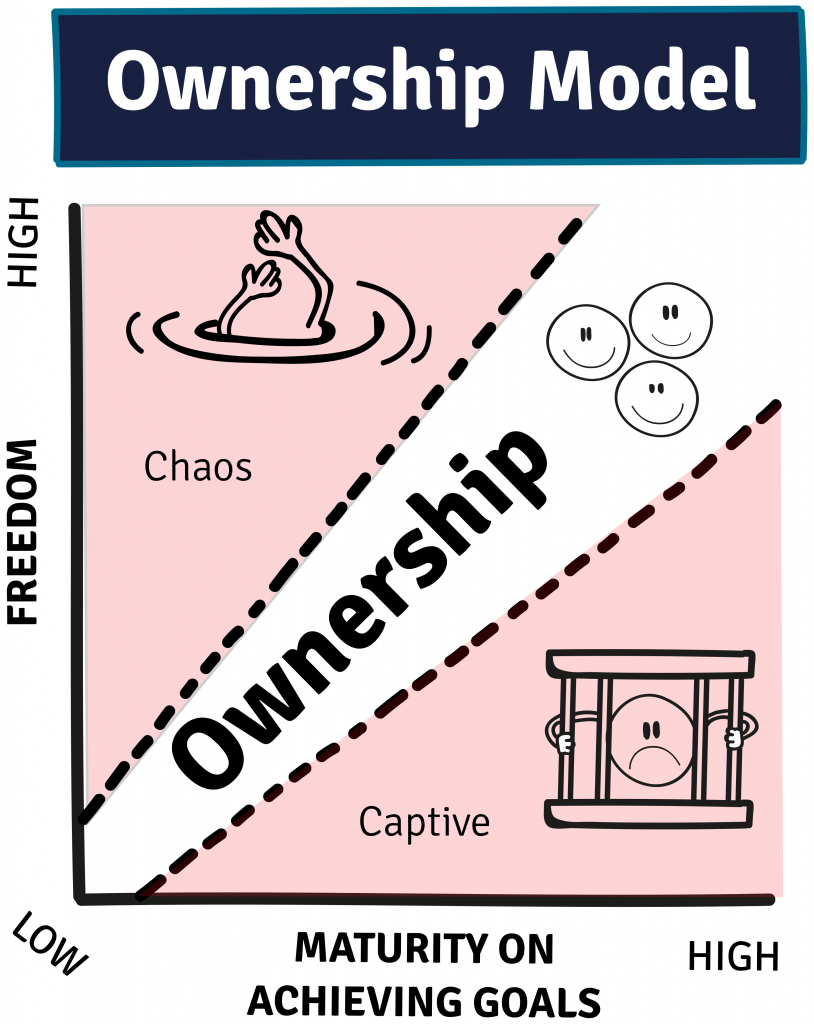What is Ownership?
When I use the term ownership, I mean that teams pick up ownership voluntarily and take responsibility for the results of a product or service. These teams are proactive and have the passion and energy to really make an impact for the users of their product. They work together, give each other feedback, exhibit resilience, are open minded, and learn continuously. They also help other teams to grow. As entrepreneurs, they take ownership of both the strategy and the way it is implemented. In addition, they realize that they own their own challenges, solutions, and customers. The product or service feels like their own child in a beautiful way. This gives teams pride, creativity, energy, passion, and satisfaction in their work.
Ownership = The mental state of a team when they feel accountable for their results. They have chosen to pick up this ownership freely and autonomously. They organize their work proactively, are transparent to each other, and continuously improve. They seek solutions and collaboration and are not searching for excuses.
Ownership cannot be imposed or enforced. It is the voluntary choice of the team to take ownership because being forced does not coincide with passion, energy, and fun. It must be granted by the leader to give the teams the ability to take ownership. It must of course also be rewarded and sustained.
Why is ownership so important?
When the work is complex, when teams have to grow continuously, and when employees have to find creative solutions every day to really help customers, something special is needed to be successful. When every situation, challenge, and customer is too unique, people need to be empowered to think and decide for themselves. Ownership ensures that they think outside the box to come up with innovative solutions that really help customers. In case of unexpected problems, difficult challenges, or when things go wrong, ownership ensures that teams feel responsible to solve this. They don’t have to wait for others to come up with solutions. When they feel ownership, they don’t blame others for their challenges. Even when it gets tough, these teams continue to look for solutions and find opportunities. This is crucial because in complex environments, solutions can only be found by exploring and experimenting, learning from failures, and continuously growing as a team. Ownership gives them momentum to overcome unexpected challenges and obstacles.What is the Ownership model?
The Ownership model visualizes the relationship between the freedom and maturity of the team. It consists of two axes, two red zones, a green zone and a staircase. Only if the freedom and maturity of the teams are in balance, the teams can take ownership. This tool looks like this:Two red zones
The two red zones (light gray in the model) arise when freedom and maturity are not in balance.Green zone
The green zone is located in the middle, the area where maturity and freedom are in balance. The team gets clarity and frameworks. At the same time they get the room for their own input. This is the ideal environment for the team to take ownership.
Horizontal axis: maturity
Maturity indicates the extent to which the team is independently capable of organizing its work and delivering products and services to its customers. Or in short: the extent to which the team can deliver self-organizing customer impact.Vertical axis: freedom
The vertical axis indicates how much freedom the teams get from the agile leader and their environment. With low freedom, they need coordination and approval for many issues and they are supplied with many details in advance.Why this tool?
Based purely on signals of passivity, low quality, employees who leave and the lack of initiative, the manager often can not determine whether stepping in or letting go is best. For this he must first know the maturity of the team and how much freedom they need to take ownership. To help with this, the Ownership Model has been developed. Using this tool, the manager can more easily talk with the teams on what needs to be done in practice. With this model it becomes immediately clear whether intervention is necessary or whether to let go is the better option.This tool is part of the Agile Leadership Toolkit
The toolkit
The steering wheel of the agile leader consists of four components. Each component consists of two practical tools. So in total eight tools. The tools are explained in such a way that leaders can immediately start working on this. The tools can be used separately and as such successful. Of course, all tools together – the toolkit – reinforce each other. It concerns the following eight tools:- KVI – the Key Value Indicator (KVI) is the most important indicator for value creation for the team.
- Impact ladder – for brainstorming and visualizing the customer impact. This helps teams continuously improve their products and services.
- Ownership model – visualizes what teams need to take ownership.
- Freedom matrix – what freedoms and responsibilities does the team have at what time.
- T2L – to measure the business agility.
- Validated Learning Board (VLB) – to visually keep track of the learning process of the team.
- Habit matrix – to support culture change and the design of new habits.
- TO-GRIP – to support the agile leader in implementing major improvements.

